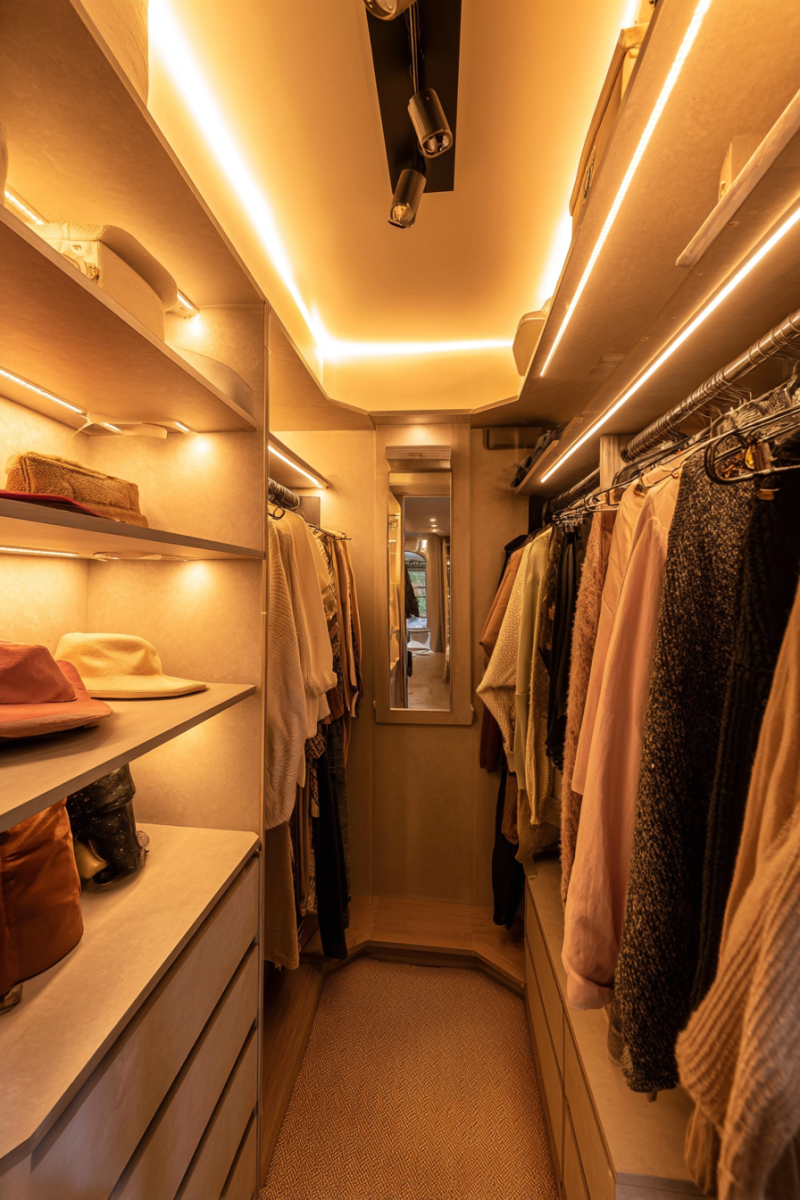Small walk-in closet organization can transform even the most chaotic space into a beautifully functional sanctuary. Have you ever opened your closet door and felt overwhelmed by the chaos inside? I’ve been there too, staring at a cramped space wondering how to make it work better. The truth is, even the smallest walk-in closet can become a beautifully organized sanctuary with the right approach.
Small walk-in closets are having a major moment right now, and for good reason. They offer that luxurious boutique feeling without requiring a mansion-sized bedroom. I’ve discovered that these compact spaces actually force us to be more creative and intentional with our storage solutions, often resulting in more functional designs than their oversized counterparts.
What I love most about small closet transformations is how they prove that size doesn’t determine style or efficiency. With smart layout choices, clever storage hacks, and thoughtful design elements, you can create a space that not only holds everything you need but also brings joy to your daily routine. No more digging through piles of clothes or losing your favorite accessories in the chaos.
In this comprehensive guide, I’m sharing 18 game-changing ideas that have helped me and countless others maximize every square inch of our walk-in closets. From vertical storage solutions that reach new heights to lighting tricks that make spaces feel twice their actual size, these strategies will help you create the organized, stylish closet of your dreams. Whether you’re working with a converted spare bedroom corner or a purpose-built compact closet, these ideas will transform how you think about small-space storage.
1. Master the Art of Vertical Storage
I always tell my clients that the biggest mistake in small closets is ignoring the space above eye level. Vertical storage transforms cramped quarters into organized havens by drawing the eye upward and creating the illusion of height. Installing shelving that reaches the ceiling gives you precious real estate for seasonal items, luggage, and rarely-used accessories.
The key is making those high shelves work for you, not against you. I recommend keeping a stylish step stool nearby and using clearly labeled storage boxes or baskets up top. This way, you can easily access everything while maintaining a clean, organized look. Consider adjustable shelving systems that let you customize heights as your storage needs change throughout the seasons.

2. Double Up with Tiered Hanging Rods
One of my favorite space-maximizing tricks is installing double hanging rods at different heights. This simple addition can literally double your hanging space without expanding your closet’s footprint. I position the top rod at standard height for longer items like dresses and coats, while the bottom rod handles shirts, blouses, and folded pants.
The beauty of this system lies in its flexibility. You can adjust the spacing based on your wardrobe needs, creating more room for short items or accommodating longer pieces. Choose sturdy rods that can handle the weight, and consider pull-down systems for the upper rod if accessibility is a concern.
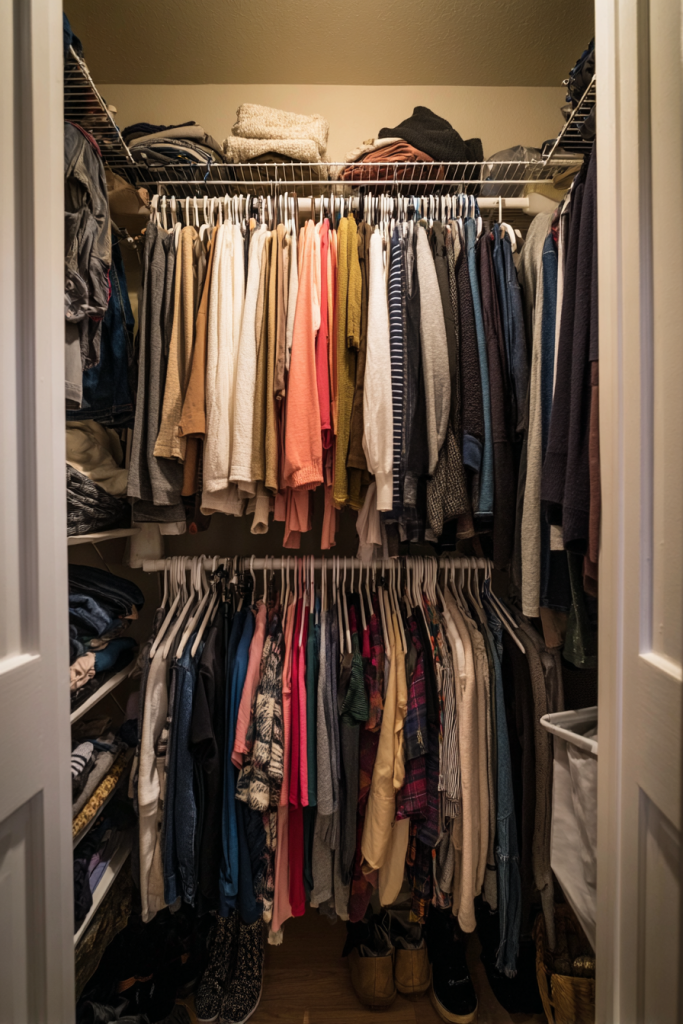
3. Transform Corners into Storage Goldmines
Corners are often the most underutilized spaces in small closets, but I’ve learned to see them as hidden storage treasures. Custom corner shelving units or rotating carousels can turn these awkward angles into highly functional storage areas. I particularly love lazy Susan-style systems that bring everything within easy reach.
For budget-friendly options, corner shoe racks or triangular shelving units work wonders. These solutions maximize every inch while keeping items visible and accessible. The trick is choosing systems that fit your corner’s exact dimensions, ensuring no space goes to waste in your compact closet.
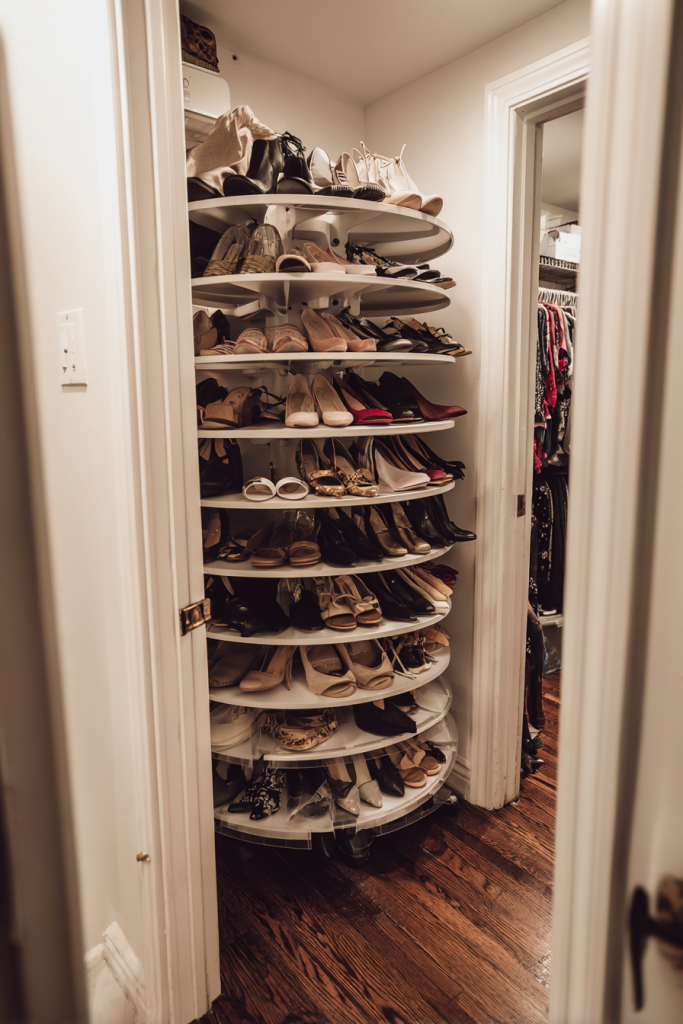
4. Install Strategic Hook Systems
Hooks might seem basic, but they’re absolute game-changers in small spaces. I strategically place them on walls, inside doors, and even on the sides of shelving units to create instant storage for frequently used items. They’re perfect for belts, scarves, jewelry, and those go-to jackets you grab daily.
The secret is choosing the right hooks for each purpose. Over-door hook systems maximize unused door space, while adhesive hooks work great for lightweight accessories. For heavier items like coats or bags, I always opt for wall-mounted hooks with proper anchoring to ensure they stay put.
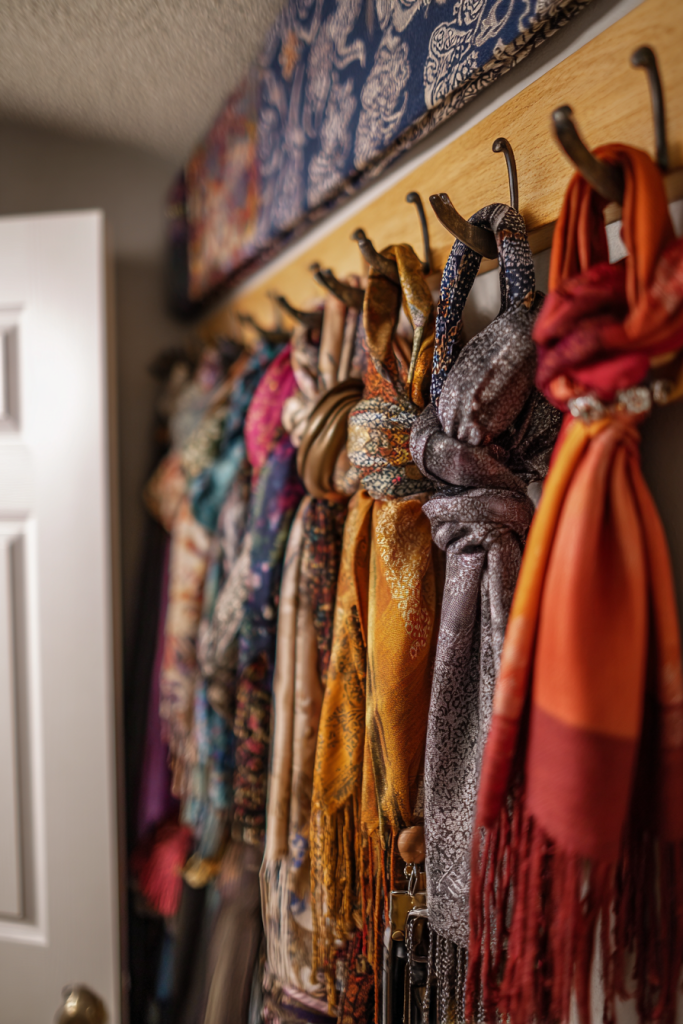
5. Embrace the Power of Slim Storage Solutions
In tight quarters, every inch matters, which is why I’m obsessed with slim storage solutions. Narrow shoe racks, thin drawer units, and slender shelving systems slip into spaces you never knew existed. These pieces prove that you don’t need bulk to create serious storage capacity.
My go-to slim solutions include over-door shoe organizers, narrow rolling carts for accessories, and thin vertical dividers for shelves. These items maximize storage density while maintaining easy access to your belongings. The key is measuring your space carefully and choosing pieces that fit perfectly without overwhelming the area.
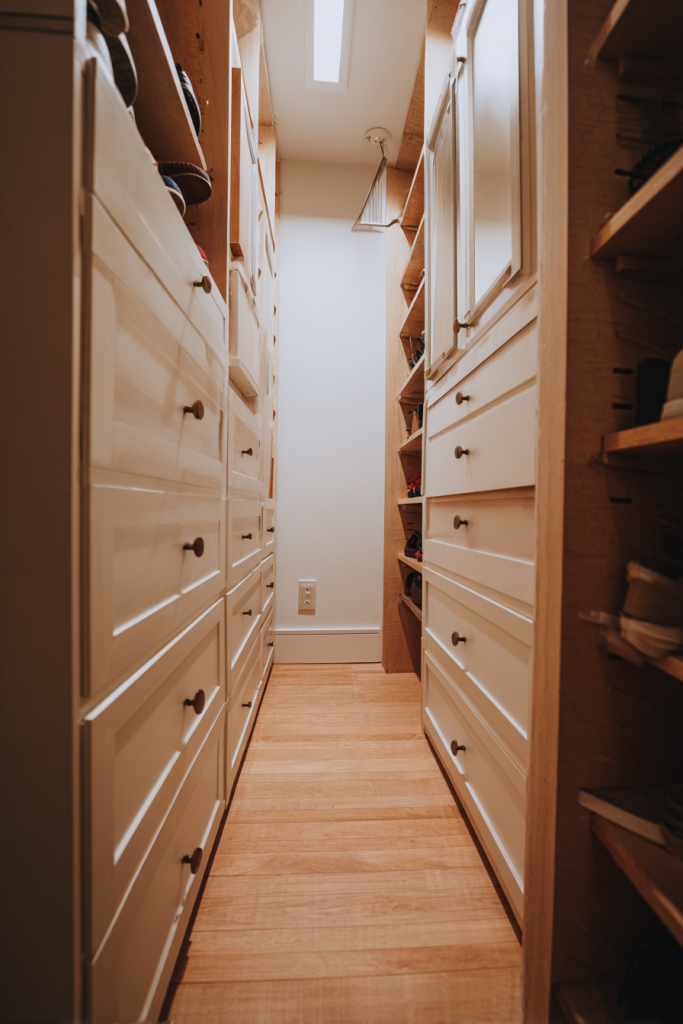
6. Create Zones for Ultimate Organization
Organization becomes effortless when you create dedicated zones for different item categories. I always establish distinct areas for work clothes, casual wear, shoes, and accessories. This zoning approach not only keeps everything tidy but also speeds up your daily routine since you know exactly where to find what you need.
Start by grouping similar items together, then assign each group a specific area in your closet. Use dividers, baskets, or different shelving heights to clearly define each zone. This method works especially well in small spaces because it prevents items from migrating and creating clutter in multiple areas.
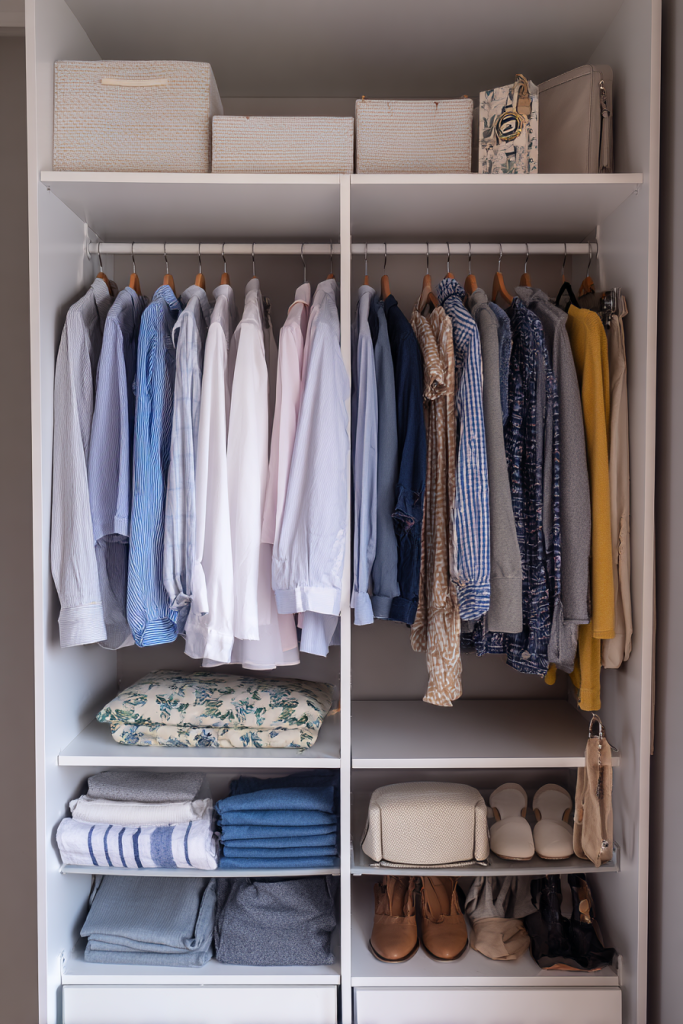
7. Maximize Door Real Estate
The back of your closet door is prime real estate that often goes completely unused. I transform these spaces into storage powerhouses with over-door organizers, mirror systems, and hook arrangements. This strategy adds significant storage capacity without taking up any floor or wall space inside the closet.
Consider full-length mirrors with built-in jewelry storage, over-door shoe organizers with clear pockets, or simple hook systems for frequently used items. The key is choosing door storage that doesn’t interfere with the door’s operation while providing easy access to your belongings.
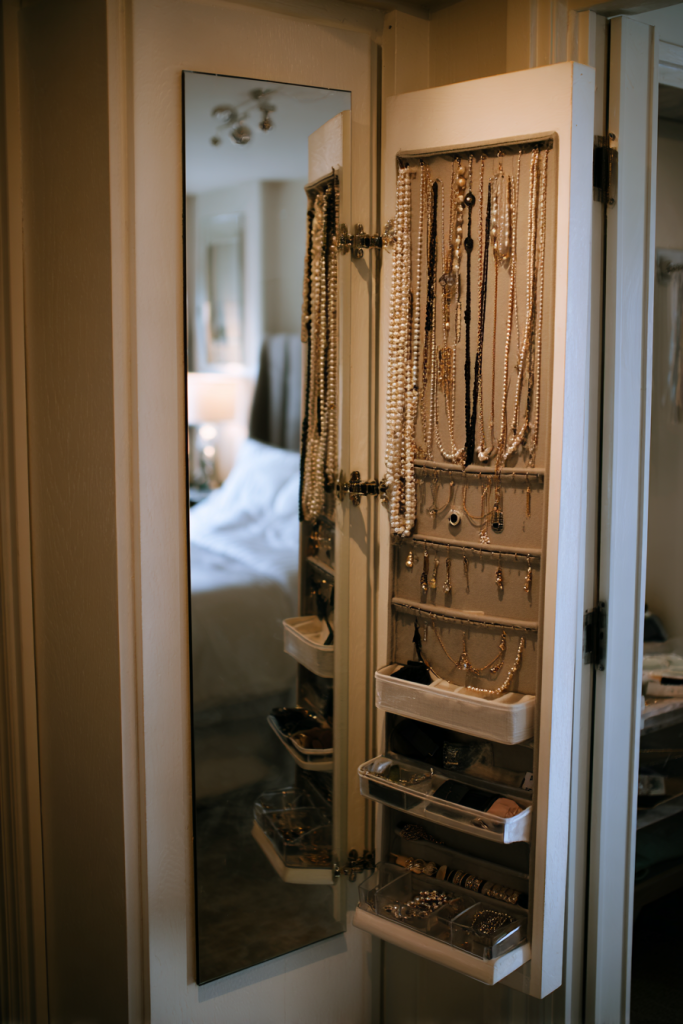
8. Light It Right for Function and Style
Proper lighting transforms a cramped closet into an inviting, functional space. I always recommend layered lighting that combines ambient, task, and accent lighting to eliminate shadows and create a boutique-like atmosphere. Good lighting also makes color matching easier and helps you find items quickly.
LED strip lights under shelves, battery-operated puck lights in dark corners, and motion-sensor ceiling fixtures are my favorite solutions. These options provide excellent illumination without requiring major electrical work. Remember that well-lit spaces always feel larger and more luxurious than dim ones.
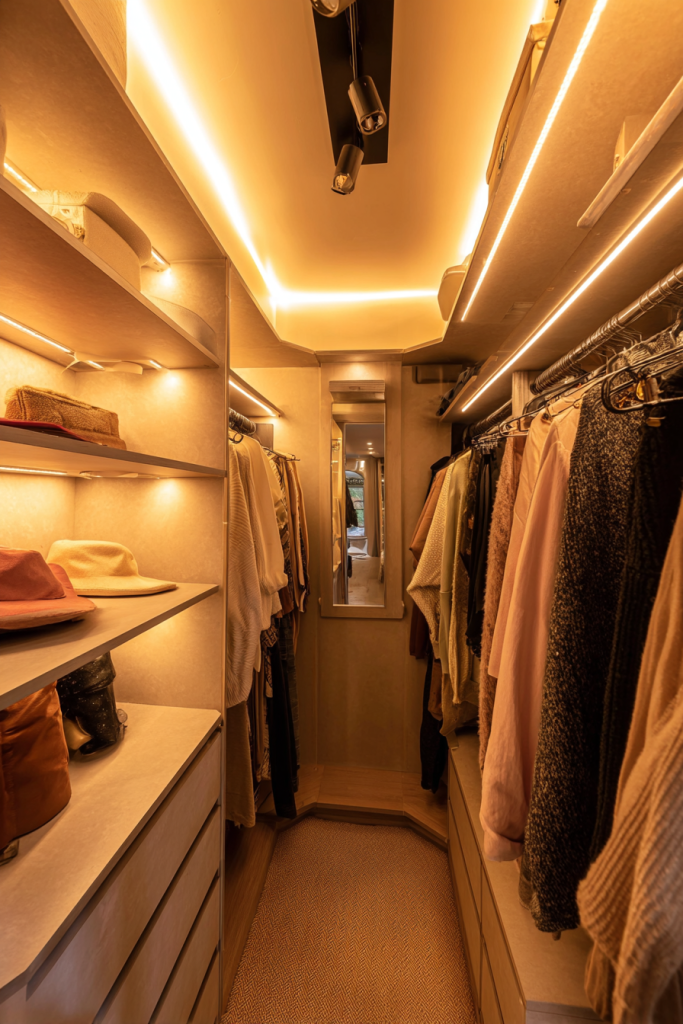
9. Mirror Magic for Visual Expansion
Mirrors are my secret weapon for making small closets feel dramatically larger. Strategic mirror placement reflects light, creates the illusion of depth, and provides essential functionality for getting dressed. I often install full-length mirrors on side walls or incorporate mirrored sliding doors for maximum impact.
The trick is positioning mirrors to reflect the most organized parts of your closet rather than cluttered areas. Mirrored closet doors serve double duty by concealing contents while making the entire room feel more spacious. Consider mirrors with built-in lighting for the ultimate luxury touch.
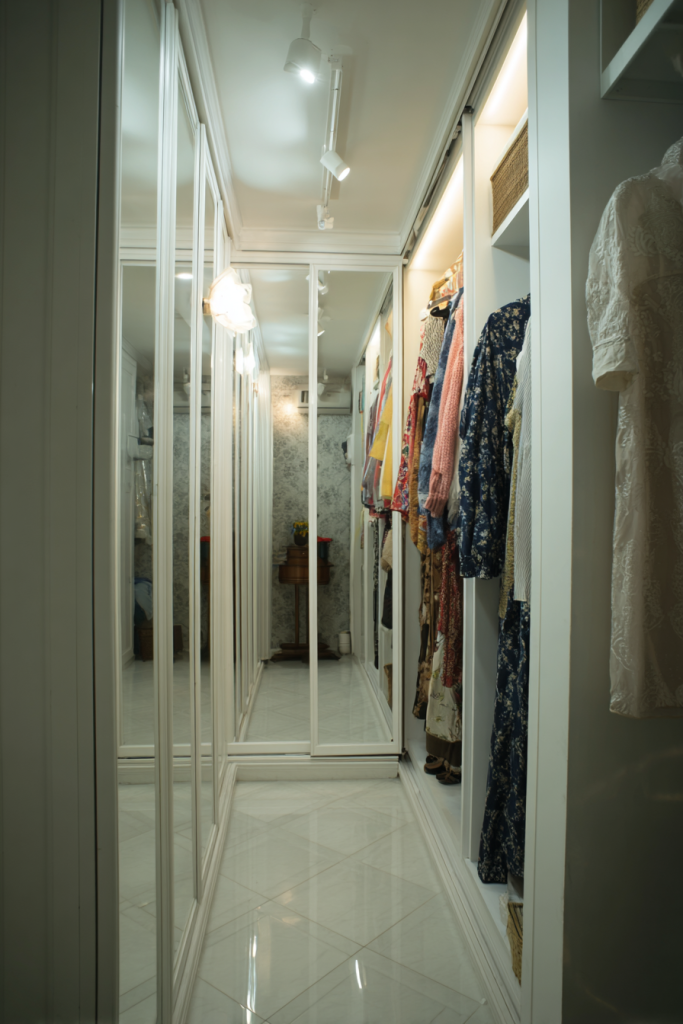
10. Smart Shelving with Adjustable Systems
Flexibility is crucial in small closets, which is why I always recommend adjustable shelving systems. These allow you to customize your storage as your needs change, accommodating everything from bulky sweaters to delicate accessories. The ability to move shelves up or down means your closet can evolve with your lifestyle.
Wire shelving, track systems, and modular units offer the most versatility. I particularly love systems that combine hanging rods, shelves, and drawers in configurable arrangements. This adaptability ensures your small closet remains functional no matter how your storage needs change over time.
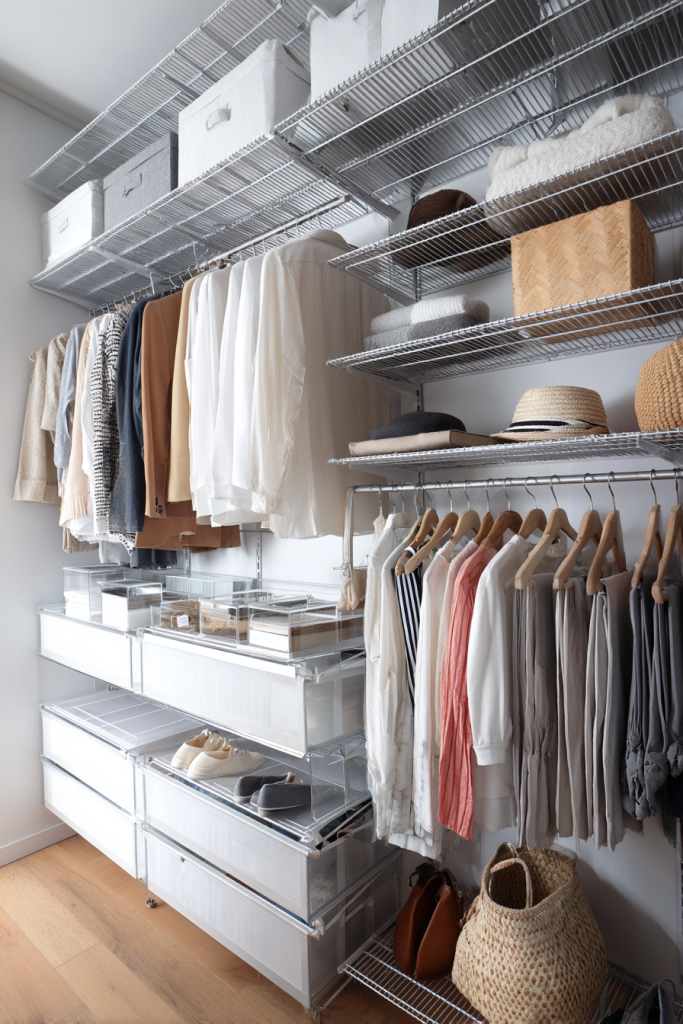
11. Drawer Systems for Hidden Organization
Built-in drawer systems are absolute lifesavers in small closets, providing concealed storage that keeps everything looking neat and organized. I love how drawers hide the visual clutter while keeping items easily accessible and properly separated. They’re perfect for undergarments, socks, jewelry, and delicate accessories that need protection from dust and damage.
Shallow drawers work best in compact spaces since they prevent items from getting buried at the bottom. Consider drawer organizers or dividers to maximize efficiency within each drawer. Pull-out drawer systems can even be retrofitted into existing shelving, giving you the benefits of drawer storage without a complete closet overhaul.
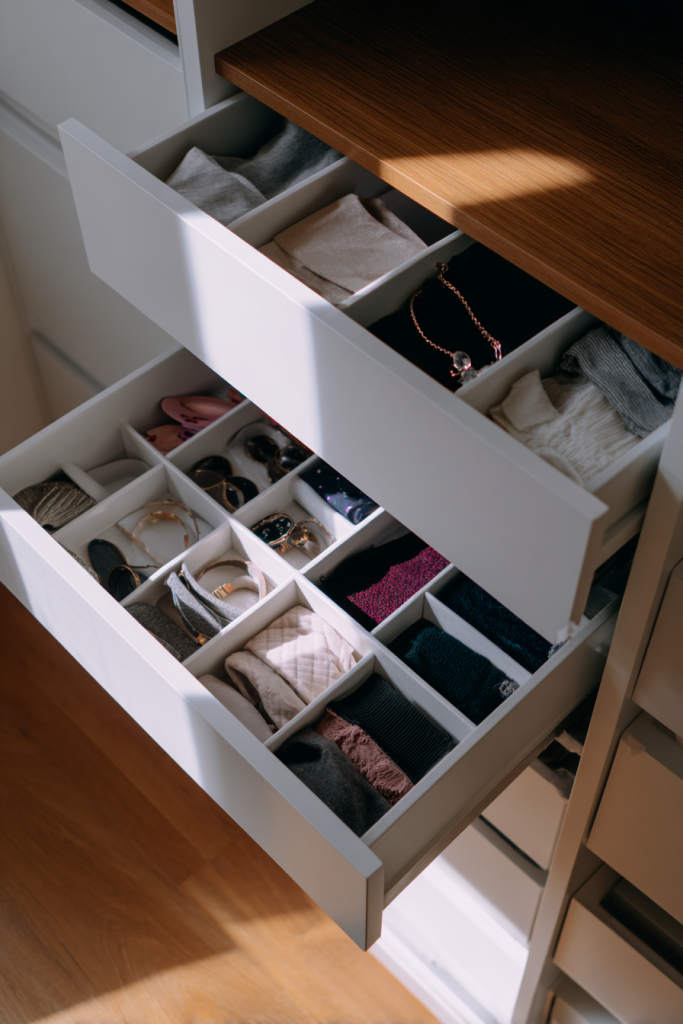
12. Utilize Every Inch of Floor Space
Floor space in small closets is precious, so I make every square inch count with smart floor-level storage solutions. Low-profile storage boxes slide under hanging clothes, while stackable cubbies create organized shoe storage without overwhelming the space. The key is choosing pieces that fit perfectly without creating obstacles to movement.
Rolling storage carts are another favorite since they provide flexibility while maximizing floor efficiency. I can easily move them to access items behind or clean the closet thoroughly. For permanent solutions, built-in floor-to-ceiling shoe cubbies or storage benches with hidden compartments make excellent use of floor real estate.
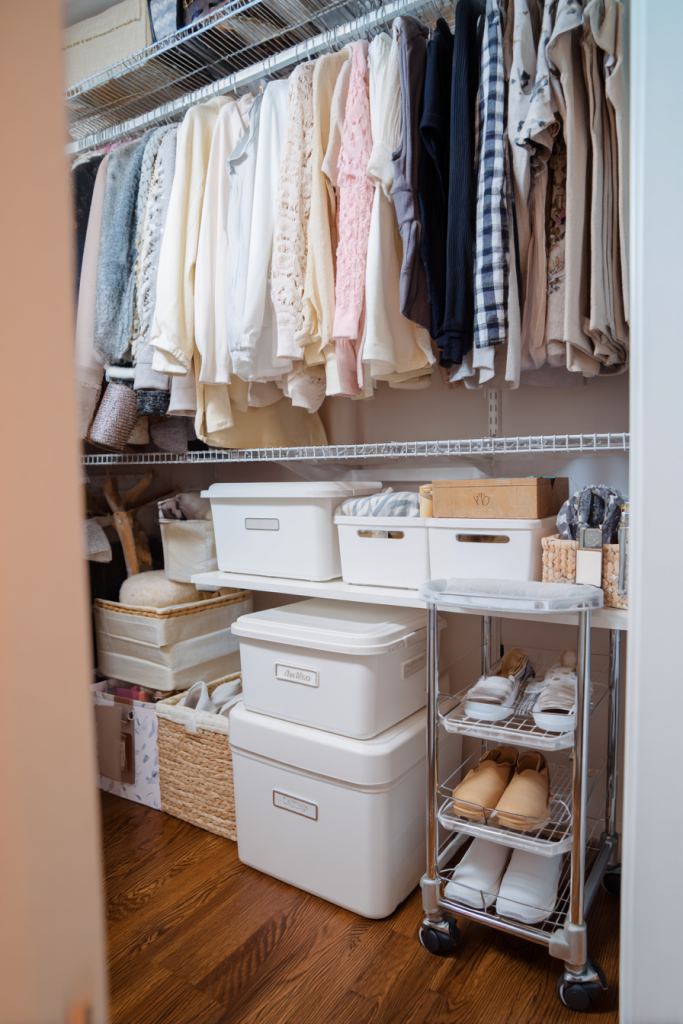
13. Color-Coordinate for Visual Calm
Color coordination transforms chaotic small closets into serene, boutique-like spaces. I organize clothes by color families, creating rainbow-like arrangements that are both beautiful and functional. This system makes outfit selection faster while creating visual order that makes the space feel larger and more luxurious.
Beyond clothing, I extend color coordination to hangers, storage boxes, and accessories. Matching slim hangers create uniformity and actually save space compared to mismatched bulky ones. Neutral-colored storage solutions maintain the calm aesthetic while keeping the focus on your beautifully organized wardrobe.
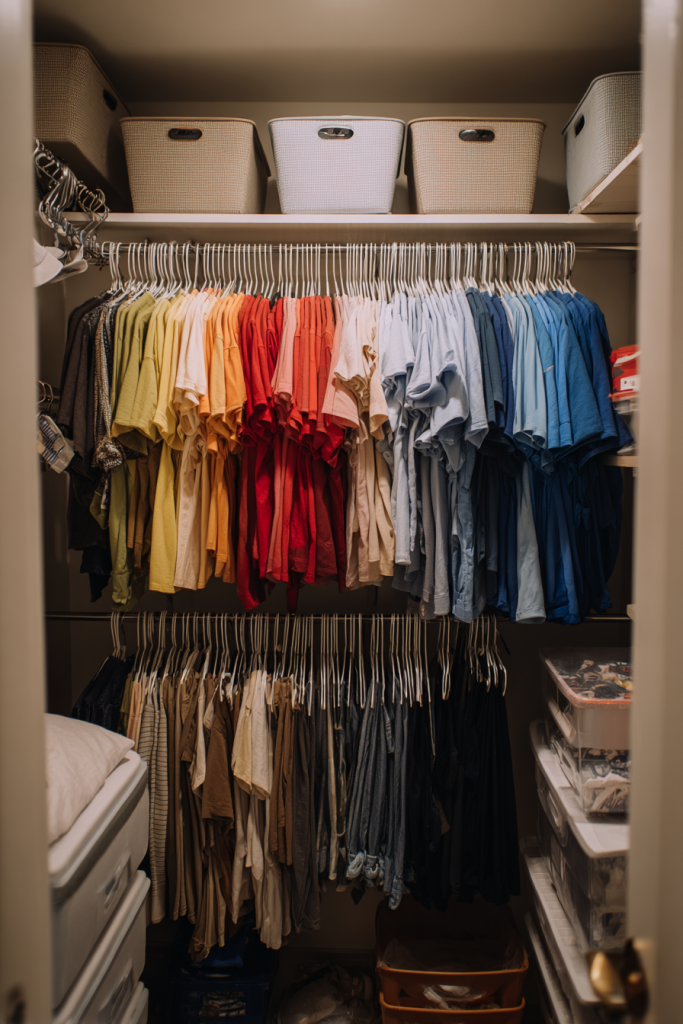
14. Seasonal Rotation Strategies
Smart seasonal rotation keeps small closets from becoming overwhelmed with out-of-season items. I designate specific areas for current-season clothes at eye level and easy-reach zones, while storing off-season items in higher or lower locations. This strategy ensures your most-used items are always accessible.
Vacuum storage bags are perfect for bulky winter items during summer months, while clear storage boxes help identify off-season pieces quickly. I always label everything clearly and keep a simple inventory list. This rotation system effectively doubles your closet’s capacity by ensuring only relevant items occupy prime real estate.
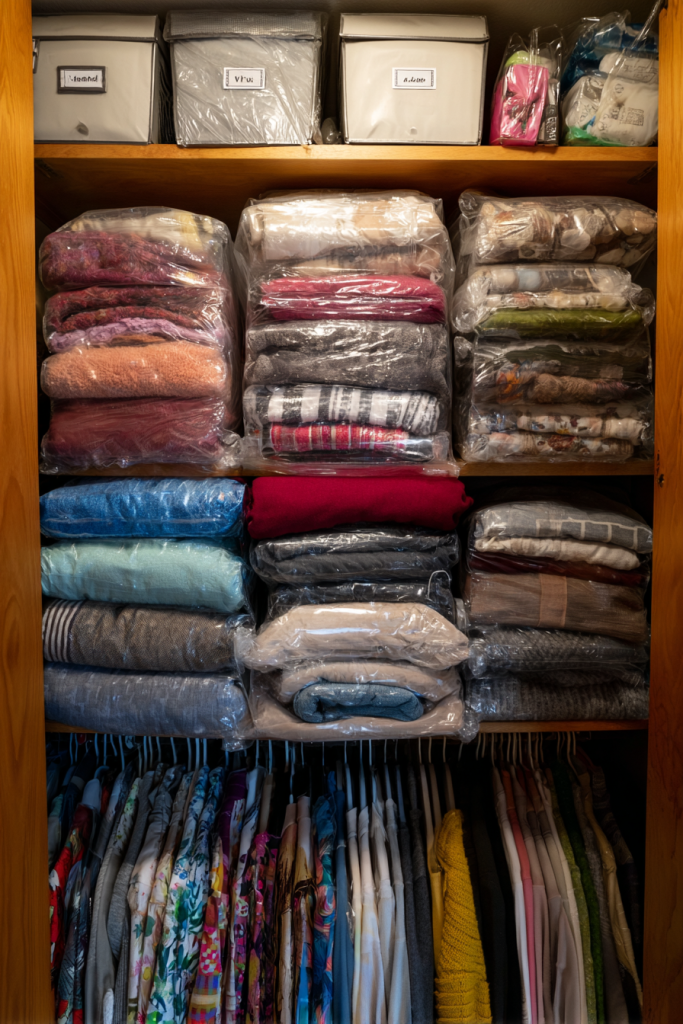
15. Built-In Accessories Organization
Dedicated accessory storage prevents small items from creating big messes in compact closets. I create specific homes for jewelry, belts, ties, and scarves using specialized organizers that maximize visibility while minimizing space usage. Everything has its place, making morning routines smoother and preventing items from getting lost or damaged.
Jewelry trays in shallow drawers, belt hooks on walls, and scarf organizers that hang from rods are my go-to solutions. For watches and statement jewelry, small display cases add a boutique touch while keeping precious items safe and organized. The investment in proper accessory storage pays off in time saved and items protected.
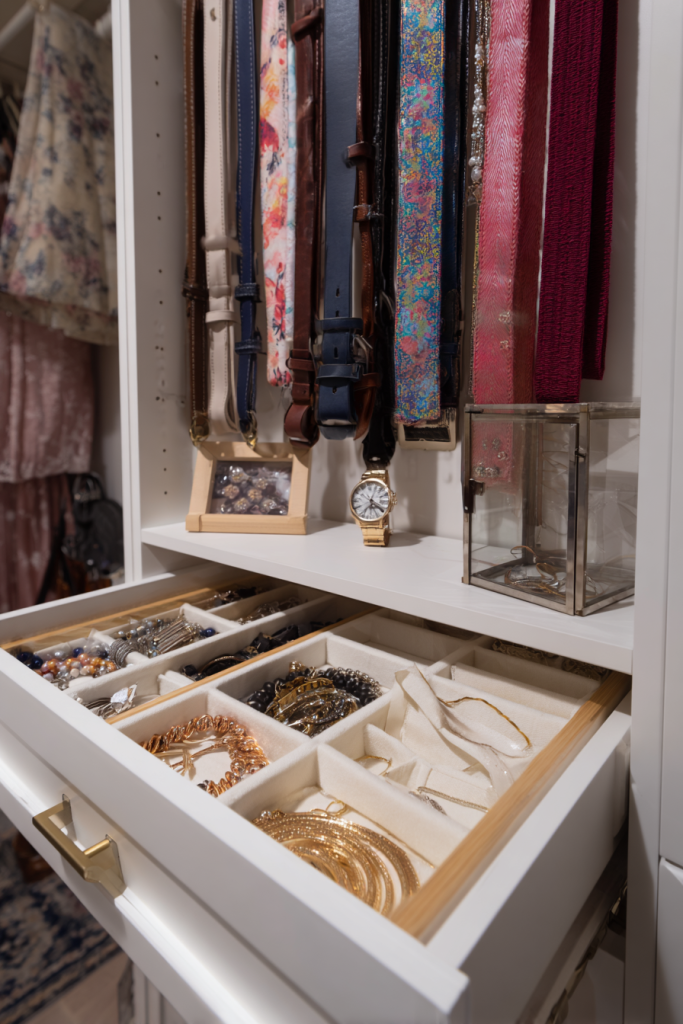
16. Multi-Functional Furniture Pieces
In small closets, every piece should serve multiple purposes to maximize efficiency. I love storage ottomans that provide seating while hiding accessories, mirrors with built-in jewelry storage, and benches with shoe storage underneath. These multi-functional pieces reduce clutter while adding practical luxury to the space.
Folding step stools that double as seats, hanging organizers with mirrors, and storage cubes that work as both seating and containers are excellent choices. The key is selecting pieces that serve your specific needs while maintaining the overall aesthetic of your closet design.
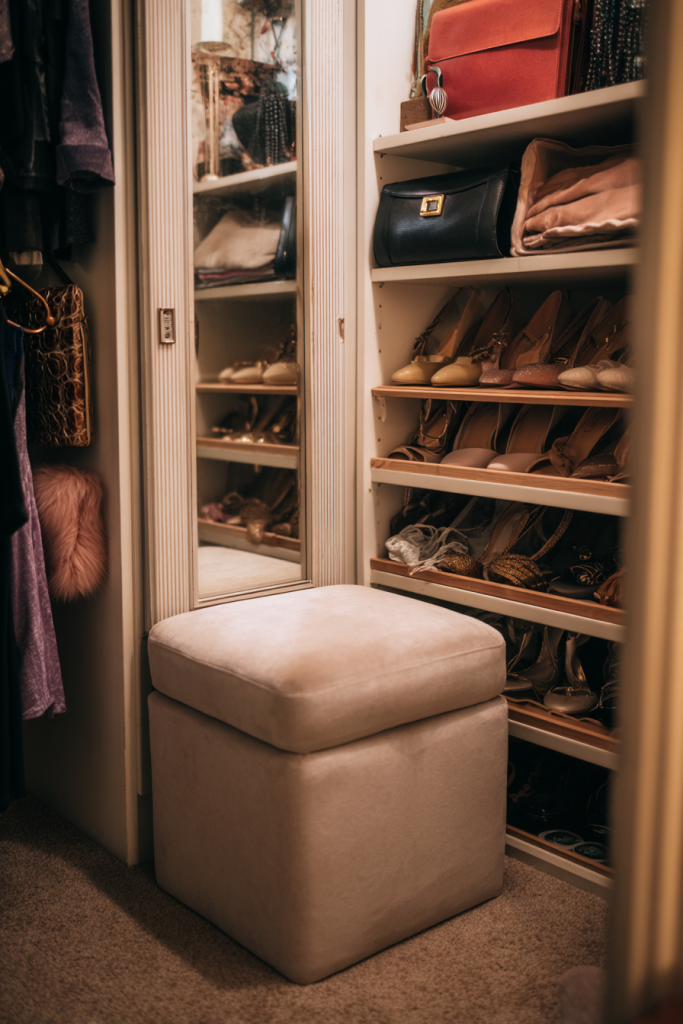
17. Maximize Awkward Spaces
Every closet has those odd nooks and awkward spaces that seem impossible to use effectively. I’ve learned to see these areas as opportunities for creative storage solutions. Slanted ceiling areas can accommodate custom shelving for shoes or accessories, while narrow spaces beside doors work perfectly for thin storage units.
Custom solutions often work best for these unique spaces, but ready-made options like narrow tower shelves, corner carousels, and over-door systems can adapt to unusual configurations. The goal is ensuring no space goes unused while maintaining easy access to stored items.
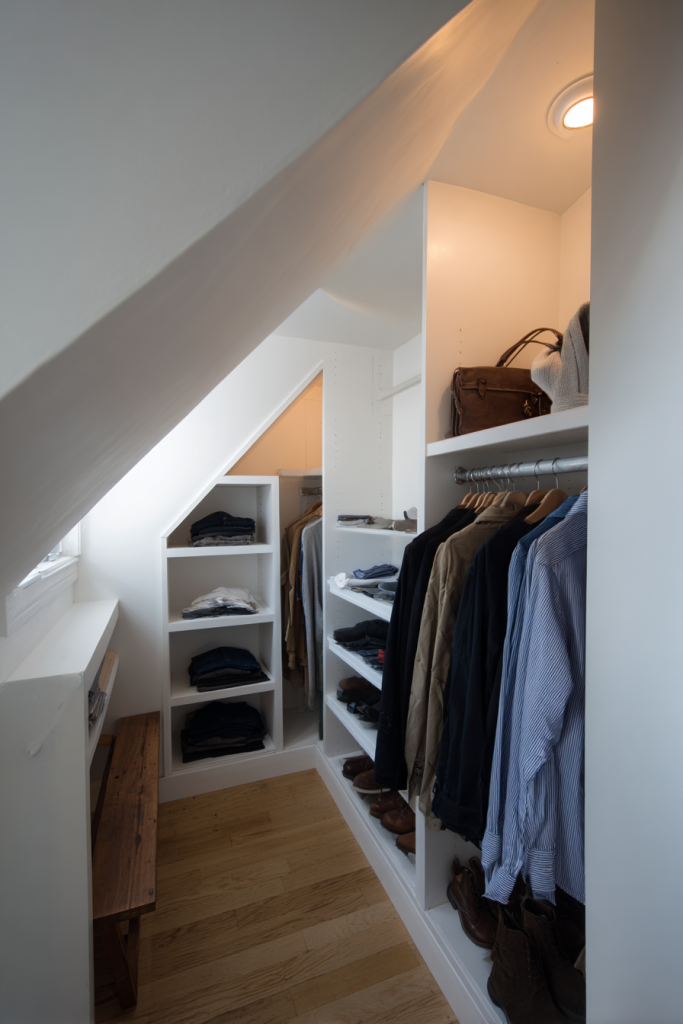
18. Professional Organization Systems
Sometimes investing in professional-grade organization systems makes the biggest difference in small closets. I recommend modular systems from companies that specialize in closet organization, as they offer superior quality and customization options. These systems often combine hanging, shelving, and drawer components in cohesive designs.
While the initial investment might be higher, professional systems offer durability, flexibility, and aesthetic cohesion that DIY solutions often lack. Many companies offer design consultations to help maximize your specific space, ensuring every component works perfectly together for optimal function and style.
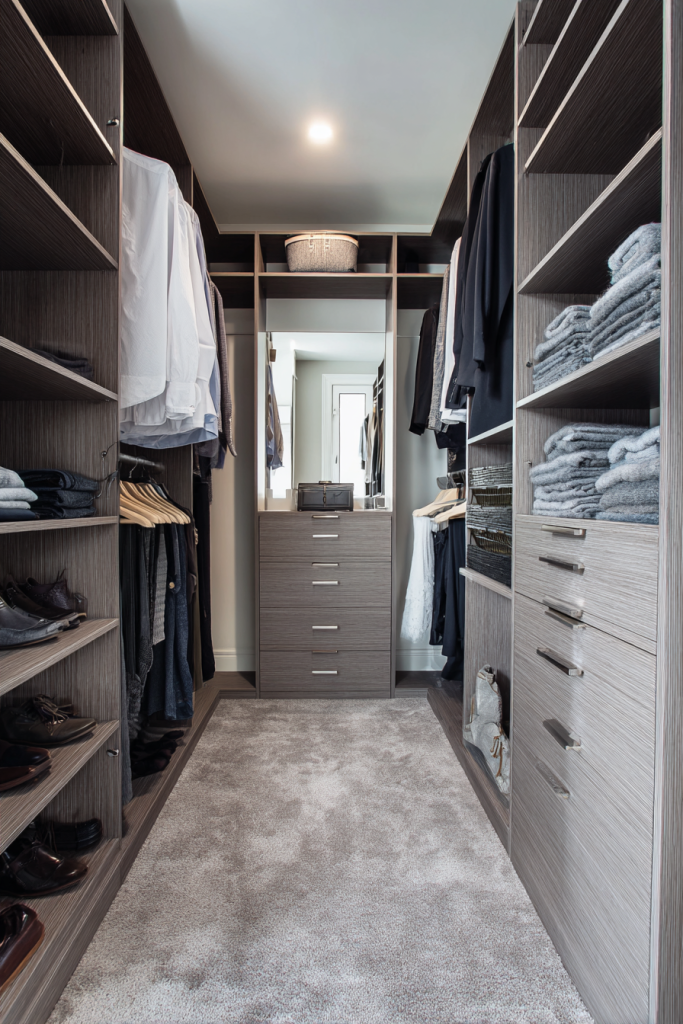
Conclusion
Transforming a small walk-in closet from cramped chaos to organized sanctuary doesn’t require a massive budget or complete renovation. With these 18 strategic approaches, you can create a space that not only holds everything you need but also brings daily joy to your routine.
The key is starting with a clear vision of how you want to use your space, then implementing solutions that work specifically for your lifestyle and storage needs. Remember that the best closet organization system is one you’ll actually maintain, so choose strategies that feel natural and sustainable for your daily habits.
Whether you implement just a few of these ideas or embrace a complete closet makeover, each small change will contribute to a more functional and beautiful space. Your small walk-in closet has incredible potential – it just needs the right approach to unlock it.
FAQ
How much does it cost to organize a small walk-in closet?
The cost varies significantly depending on your approach. DIY solutions using basic shelving, hooks, and storage containers can cost $200-500. Mid-range improvements with adjustable systems and better storage solutions typically run $500-1,500. Professional custom closet systems can cost $1,500-5,000+ depending on materials and complexity.
What’s the most important element in small closet design?
Maximizing vertical space is typically the most impactful change you can make. Most people only use the middle portion of their closet, leaving valuable space unused above and below. Installing floor-to-ceiling storage solutions immediately increases your capacity while making the space feel more organized and intentional.
How do I maintain organization in a small closet?
Success comes from creating systems that match your daily habits. Assign specific homes for every item type, use the “one in, one out” rule to prevent overcrowding, and do a quick 5-minute tidy-up weekly. Seasonal decluttering and rotation keep the space from becoming overwhelmed with unused items.
Can I organize a small closet without built-ins?
Absolutely! Many effective solutions require no permanent installation. Over-door organizers, freestanding shelving units, hooks that hang from rods, and stackable storage systems can transform your space without any construction. These portable solutions work especially well for renters or those wanting flexibility.
What’s the best way to maximize hanging space?
Double hanging rods at different heights typically double your hanging capacity. Use the upper rod for longer items like dresses and coats, while the lower rod handles shirts, blouses, and pants. Slim matching hangers also save significant space compared to bulky or mismatched hangers.

